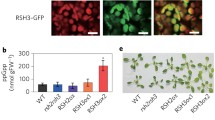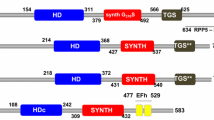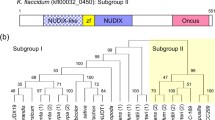Abstract
The regulatory nucleotides, guanosine 5′-triphosphate 3′-diphosphate (pppGpp) and guanosine 5′-diphosphate 3′-diphosphate (ppGpp), were originally identified in Escherichia coli, and control a large set of gene expression and enzyme activities. The (p)ppGpp-dependent control of cell activities is referred to as the stringent response. A growing number of (p)ppGpp synthase/hydrolase homologs have been identified in plants, which are localized in plastids in Arabidopsis thaliana. We recently reported that the Arabidopsis mutant overproducing ppGpp in plastids showed dwarf chloroplasts, and transcript levels in the mutant plastids were significantly suppressed. Furthermore, the mutant showed more robust growth than the wild type (WT), especially under nutrient-deficient conditions, although the mechanisms are unclear. To better understand the impact of the ppGpp accumulation on plant responses to nutrient deficiency, photosynthetic activities and metabolic changes in the ppGpp-overproducing mutant were characterized here. Upon transition to the nitrogen-deficient conditions, the mutant showed reduction of ribulose 1,5-bisphosphate carboxylase/oxygenase (RubisCO) contents, and effective and maximum quantum yield of photosystem II compared with WT. The mutant also showed more obvious changes in key metabolite levels including some amino acid contents than WT; similar metabolic change is known to be critical for plants to maintain carbon–nitrogen balance in their cells. These results suggest that artificially overproducing ppGpp modulates the organelle functions that play an important role in controlling photosynthetic performance and metabolite balance during nitrogen starvation.






Similar content being viewed by others
References
Atkinson GC, Tenson T, Hauryliuk V (2011) The RelA/SpoT homolog (RSH) superfamily: distribution and functional evolution of ppGpp synthetases and hydrolases across the tree of life. PLoS One 6:67 e23479
Battesti A, Bouveret E (2006) Acyl carrier protein/SpoT interaction, the switch linking SpoT-dependent stress response to fatty acid metabolism. Mol Microbiol 62:1048–1063
Brown A, Fernandez IS, Gordiyenko Y, Ramakrishnan V (2016) Ribosome-dependent activation of stringent control. Nature 534:277–280
Cashel M (1969) The control of ribonucleic acid synthesis in Escherichia coli IV. Relevance of unusual phosphorylated compounds from amino acid-starved stringent strains. J Biol Chem 244:3133–3141
Cashel M, Gentry DR, Hernandez VJ, Vinella D (1996) The stringent response. In: Neidhardt FC, Curtiss IR, Ingraham JL et al (eds) Escherichia coli and Salmonella: cellular and molecular biology, 2nd edn. ASM Press, Washington D.C., pp 1458–1496
Evans JR (1989) Photosynthesis and nitrogen relationships in leaves of C3 plants. Oecologia 78:9–19
Eveland AL, Jackson DP (2012) Sugars, signalling, and plant development. J Exp Bot 63:3367–3377
Givens RM, Lin M-H, Taylor DJ et al (2004) Inducible expression, enzymatic activity, and origin of higher plant homologues of bacterial RelA/SpoT stress proteins in Nicotiana tabacum. J Biol Chem 279:7495–7504
Hauryliuk V, Atkinson GC, Murakami KS et al (2015) Recent functional insights into the role of (p)ppGpp in bacterial physiology. Nat Rev Microbiol 13:298–309
Hirai MY, Yano M, Goodenowe DB, et al (2004) Integration of transcriptomics and metabolomics for understanding of global responses to nutritional stresses in Arabidopsis thaliana. Proc Natl Acad Sci USA 101:10205–10210
Ihara Y, Masuda S (2016) Cytosolic ppGpp accumulation induces retarded plant growth and development. Plant Signal Behav 11:e1132966
Ihara Y, Ohta H, Masuda S (2015) A highly sensitive quantification method for the accumulation of alarmone ppGpp in Arabidopsis thaliana using UPLC-ESI-qMS/MS. J Plant Res 128:511–518
Ito D, Ihara Y, Nishihara H, Masuda S (2017) Phylogenetic analysis of proteins involved in the stringent response in plant cells. J Plant Res. doi: 10.1007/s10265-017-0922-8
Kang J, Turano FJ (2003) The putative glutamate receptor 1.1 (AtGLR1.1) functions as a regulator of carbon and nitrogen metabolism in Arabidopsis thaliana. Proc Natl Acad Sci USA 100:6872–6877
Loveland AB, Bah E, Madireddy R, et al (2016) Ribosome-RelA structures reveal the mechanism of stringent response activation. Elife 5:e17029
Maekawa M, Honoki R, Ihara Y, et al (2015) Impact of the plastidial stringent response in plant growth and stress responses. Nat Plants 1:15167
Masuda S (2012) The stringent response in phototrophs. In: Najafpour M (ed) Advances in photosynthesis. In Tech, Rijeka, pp 487–500
Masuda S, Mizusawa K, Narisawa T et al (2008) The bacterial stringent response, conserved in chloroplasts, controls plant fertilization. Plant Cell Physiol 49:135–141
Mizusawa K, Masuda S, Ohta H (2008) Expression profiling of four RelA/SpoT-like proteins, homologues of bacterial stringent factors, in Arabidopsis thaliana. Planta 228:553–562
Murata N, Takahashi S, Nishiyama Y, Allakhverdiev SI (2007) Photoinhibition of photosystem II under environmental stress. Biochim Biophys Acta Bioenerg 1767:414–421
Nunes-Nesi A, Fernie AR, Stitt M (2010) Metabolic and signaling aspects underpinning the regulation of plant carbon nitrogen interactions. Mol Plant 3:973–996
Oikawa A, Fujita N, Horie R et al (2011) Solid-phase extraction for metabolomic analysis of high-salinity samples by capillary electrophoresis-mass spectrometry. J Sep Sci 34:1063–1068
Paul MJ, Pellny TK (2003) Carbon metabolite feedback regulation of leaf photosynthesis and development. J Exp Bot 54:539–547
Paul MJ, Stitt M (1993) Effects of nitrogen and phosphorus deficiencies on levels of carbohydrates, respiratory enzymes and metabolites in seedlings of tobacco and their response to exogenous sucrose. Plant Cell Environ 16:1047–1057
Porra R, Thompson W, Kriedemann P (1989) Determination of accurate extinction coefficients and simultaneous equations for assaying chlorophylls a and b extracted with four different solvents: verification of the concentration of chlorophyll standards by atomic absorption spectroscopy. Biochim Biophys Acta 975:384–394
Potrykus K, Cashel M (2008) (p)ppGpp: still magical? Annu Rev Microbiol 62:35–51
Rolland F, Baena-Gonzalez E, Sheen J (2006) Sugar sensing and signaling in plants: conserved and novel mechanisms. Annu Rev Plant Biol 57:675–709
Sato T, Maekawa S, Yasuda S et al (2009) CNI1/ATL31, a RING-type ubiquitin ligase that functions in the carbon/nitrogen response for growth phase transition in Arabidopsis seedlings. Plant J 60:852–864
Sato M, Takahashi T, Ochi K, et al (2015) Overexpression of RelA/SpoT homologs, PpRSH2a and PpRSH2b, induces the growth suppression of the moss Physcomitrella patens. Biosci Biotech Biochem 79:36–44
Scheible WR, Morcuende R, Czechowski T et al (2004) Genome-wide reprogramming of primary and secondary metabolism, protein synthesis, cellular growth processes, and the regulation infrastructure of Arabidopsis in response to nitrogen. Plant Physiol 136:2483–2499
Sugliani M, Abdelkefi H, Ke H et al (2016) An ancient bacterial signaling pathway regulates chloroplast function to influence growth and development in Arabidopsis. Plant Cell 28:661–679
Takahashi K, Kasai K, Ochi K (2004) Identification of the bacterial alarmone guanosine 5′-diphosphate 3′-diphosphate (ppGpp) in plants. Proc Natl Acad Sci USA 101:4320–4324
Ticconi CA, Delatorre CA, Abel S (2001) Attenuation of phosphate starvation responses by phosphite in Arabidopsis. Plant Physiol 127:963–972
Tozawa Y, Nomura Y (2011) Signalling by the global regulatory molecule ppGpp in bacteria and chloroplasts of land plants. Plant Biol (Stuttg) 13:699–709
Tozawa Y, Nozawa A, Kanno T et al (2007) Calcium-activated (p)ppGpp synthetase in chloroplasts of land plants. J Biol Chem 282:35536–35545
Tschoep H, Gibson Y, Carillo P et al (2009) Adjustment of growth and central metabolism to a mild but sustained nitrogen-limitation in Arabidopsis. Plant Cell Environ 32:300–318
Uhrig RG, Ng KKS, Moorhead GBG (2009) PII in higher plants: a modern role for an ancient protein. Trends Plant Sci 14:505–511
van der Biezen EA, Sun J, Coleman MJ, et al (2000) Arabidopsis RelA/SpoT homologs implicate (p)ppGpp in plant signaling. Proc Natl Acad Sci USA 97:3747–3752
Vidal EA, Gutiérrez AR (2008) A systems view of nitrogen nutrient and metabolite responses in Arabidopsis. Curr Opin Plant Biol 11:521–529
Wingler A, Mares M, Pourtau N (2004) Spatial patterns and metabolic regulation of photosynthetic parameters during leaf senescence. New Phytol 161:781–789
Wingler A, Purdy S, MacLean A, Pourtau N (2006) The role of sugars in integrating environmental signals during the regulation of leaf senescence. J Exp Bot 57:391–399
Xiong Y, Sheen J (2014) The role of target of rapamycin signaling networks in plant growth and metabolism. Plant Physiol 164:499–512
Acknowledgements
We thank Ryoichi Sato at Tokyo Institute of Technology for valuable discussion and Lucy Kwok at Tokyo Institute of Technology for critical reading of the manuscript. This work was supported by a Grant-in-Aid for Scientific Research, KAKENHI (17H05719, 16K14694, and 16H03280) to SM.
Author information
Authors and Affiliations
Corresponding author
Additional information
Rina Honoki and Sumire Ono have contributed equally to this work.
Electronic supplementary material
Below is the link to the electronic supplementary material.
Rights and permissions
About this article
Cite this article
Honoki, R., Ono, S., Oikawa, A. et al. Significance of accumulation of the alarmone (p)ppGpp in chloroplasts for controlling photosynthesis and metabolite balance during nitrogen starvation in Arabidopsis . Photosynth Res 135, 299–308 (2018). https://doi.org/10.1007/s11120-017-0402-y
Received:
Accepted:
Published:
Issue Date:
DOI: https://doi.org/10.1007/s11120-017-0402-y




